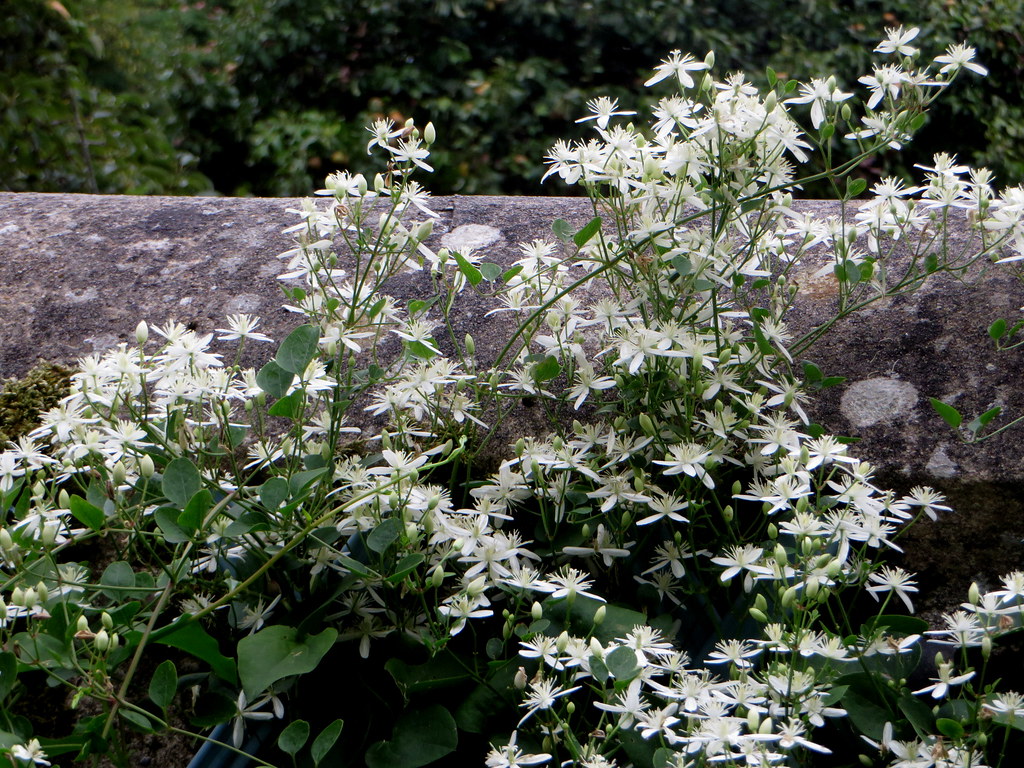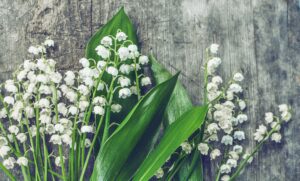In this article we will explore several enchanting climbing plants that stand out in fall, adding richness and character to your landscape.
Virginia Creeper
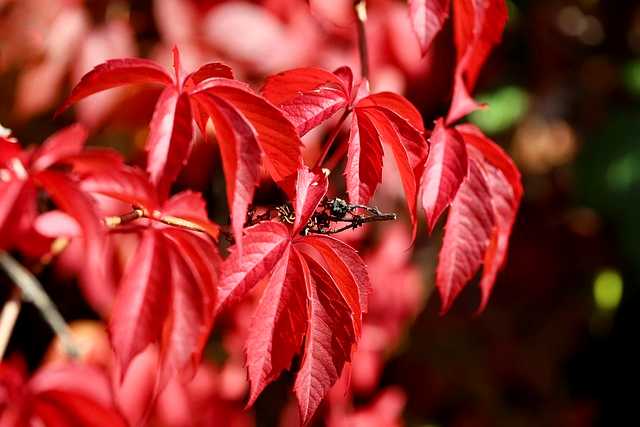
Virginia Creeper (Parthenocissus quinquefolia) is a vigorous climber appreciated for its dazzling fall foliage. While this perennial vine grows abundantly in various habitats across North America, its dramatic transformation in autumn captivates gardeners and nature enthusiasts alike. The leaves of Virginia Creeper turn a brilliant crimson, making it a striking backdrop in conjunction with the golden tones of other plants.
This hardy plant is remarkably versatile, thriving in diverse soil types and light conditions, from full sun to partial shade. Its ability to adapt creates unique opportunities for gardeners looking to cover less desirable areas or enhance vertical spaces. Virginia Creeper is also a favorite among wildlife, providing shelter and food for various bird species during the colder months.
When considering this plant for your garden, it’s important to remember that its growth can be vigorous—so plan for regular maintenance to prevent it from overwhelming neighboring plants or garden structures. This inherent resilience and beauty make Virginia Creeper a beloved choice for fall aesthetics.
Silver Lace Vine

The Silver Lace Vine, known for its lush greenery and delicate white flowers, is another excellent climbing plant that flourishes in the autumn months. This perennial vine can grow up to 20 feet in a single growing season, creating a stunning archway or draping beautifully over pergolas or fences. As summer transitions to fall, the white blooms give way to fluffy seed heads that flutter in the breeze, providing visual interest even as many plants begin to shut down for the season.
What makes Silver Lace Vine particularly appealing is its ability to thrive in a variety of conditions, be it full sun or partial shade. It’s drought-tolerant once established and works well in poor soils, making it an attractive option for those who may not have the most hospitable gardening conditions.
While it does produce lovely flowers and interesting seedheads, the plant’s rapid growth can necessitate some level of management to prevent it from becoming invasive. Regular pruning can help maintain control and promote new growth that can bloom during the late summer and early fall. Its unique combination of vigor and beauty makes it a fantastic addition to any garden looking to expand its climbing repertoire.
Ornamental Purple-Leaf Grape

Ornamental Purple-Leaf Grape (Vitis vinifera ‘Purpurea’) is an exquisite climbing vine that piques interest with its striking foliage. This versatile plant boasts stunning dark purple leaves that create a dramatic contrast against other garden elements. As the year winds down, the leaves transition into an array of rich colors, displaying deep burgundy and amber tones that are truly breathtaking.
Beyond its aesthetic appeal, this grapevine is a practical choice for climbers. It can be grown on trellises, arbors, or even left to sprawl across the ground, creating a tapestry of colors and textures late into the fall. While the plant does produce small grapes, it’s primarily valued for its ornamental qualities rather than fruit production.
Growers appreciate its adaptability, as it flourishes in a variety of conditions, thriving in both sunny and partially shaded areas. Additionally, its resistance to pests and diseases makes it a low-maintenance choice for gardeners looking to enjoy fall color without constant vigilance. With its lush foliage and ability to create a colorful cascade, the Ornamental Purple-Leaf Grape stands out as a splendid addition to any fall landscape.
Sweet Autumn Clematis
Sweet Autumn Clematis (Clematis terniflora) is a robust flowering vine that takes center stage as the days shorten and the temperatures begin to cool. Renowned for its abundant clusters of small, fragrant white flowers, this clematis variety infuses gardens with a delightful scent that fills the air each autumn. The flowers bloom from late summer to early fall, creating a stunning display against the backdrop of fading summer foliage.
What sets Sweet Autumn Clematis apart is its rapid growth rate and ability to cover structures in no time, making it an ideal choice for trellises, fences, and pergolas. This climbing plant not only brings beauty to vertical spaces but also offers essential food sources for pollinators like bees and butterflies in late-season gardens.
While this clematis thrives in full sun, it is also tolerant of partial shade, making it versatile for different garden conditions. Once established, it is relatively low maintenance, requiring only the occasional pruning after blooming to maintain its shape and encourage future growth. With its mesmerizing blossoms and enchanting fragrance, Sweet Autumn Clematis is a true gem in the realm of fall climbing plants.
Kiwi Vine
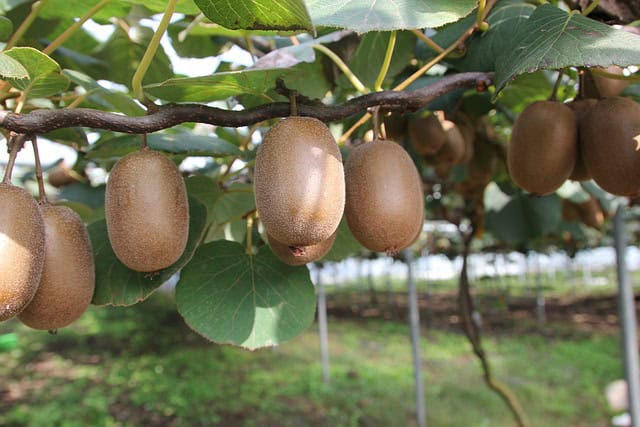
The Kiwi Vine (Actinidia deliciosa) dazzles in fall with its striking foliage, showcasing attractive heart-shaped leaves that turn shades of yellow and gold as the season progresses. This vigorous climbing plant is not only aesthetically pleasing but also offers the potential for delicious fruit, depending on the cultivar. Many gardeners relish the idea of growing their own kiwi, as it can flourish on sturdy trellises or fences, transforming ordinary structures into lush gardens.
While the plant is known for its impressive, lush growth, patience is key when it comes to fruit production. Typically, the female kiwi vine produces fruits, while the male vine serves to pollinate. When planting, ensure to include both to yield a fruitful harvest. Late summer to early fall is especially noteworthy, as the vines can drape elegantly, showcasing their stunning foliage and vibrant blooms.
Kiwi Vines prefer well-drained soil and require a sunny location to thrive, but they can adapt to various soil types. Additionally, once established, the vines exhibit moderate drought resistance. Regular pruning during the dormant season encourages better air circulation, making it easier to maintain healthy growth. The promise of tasty, sweet kiwis and the beautiful fall transformation make Kiwi Vines a fascinating addition to any climbing plant collection.
American Bittersweet
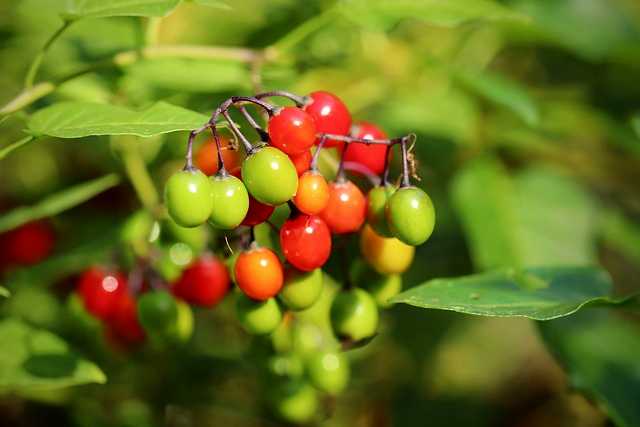
American Bittersweet (Celastrus scandens) brings a splash of vibrant color to the fall landscape with its striking orange and yellow berries that cling to the vines. This twining vine is often sought after for its dramatic display, as its colorful fruit is set against dark green leaves that turn golden in the fall. As autumn progresses, the berries burst open, revealing the bright seeds inside, which serve as a valuable food source for birds and other wildlife.
However, it is essential to recognize the plant’s vigorous nature; American Bittersweet can become invasive if not managed properly. To harness its potential without compromising other plants in your garden, consider growing it in controlled environments or in areas where it can flourish without interfering with more delicate species. Regular maintenance through pruning is advisable to keep the vine in check and encourage bushier growth.
In addition to its ornamental appeal, American Bittersweet features small, fragrant flowers in the spring, which attract pollinators. This climbing plant thrives best in full sun and well-drained soil, making it an adaptable option for various garden settings. With its rich historical significance and charming fall display, the American Bittersweet is a captivating choice for anyone looking to add an element of drama to their vertical gardening spaces.
Boston Ivy
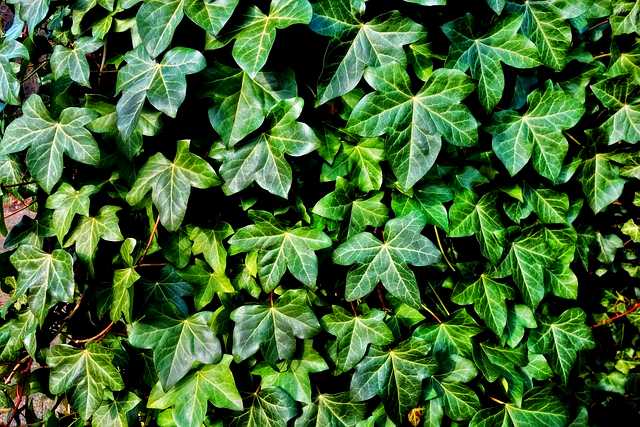
Boston Ivy (Parthenocissus tricuspidata) is a classic climbing plant prized for its exceptional ability to create stunning visual displays, particularly during the fall season. This ivy is famous for its incredible transformation as the leaves transition from deep green to vivid shades of red and purple, providing an eye-catching spectacle that can brighten any wall, trellis, or fence. Its active growth habit allows it to cover vertical spaces quickly, making it an excellent option for those seeking rapid coverage.
Boston Ivy thrives in full sun to partial shade and adapts well to a variety of soil types. Unlike many climbing plants, it grabs onto surfaces using small adhesive pads, allowing it to clime brick, stone, and wood with ease. This attribute not only contributes to its robustness but also presents a low-maintenance solution for achieving a dramatic look without the need for support structures.
Additionally, the plant is known for its resilience; it can withstand urban pollution and environmental stress, making it suitable for city gardens. Boston Ivy’s multi-season appeal, along with its ability to attract birds and insects, renders it a valuable asset in the landscape. With its iconic fall foliage and adaptability, Boston Ivy is an excellent choice for gardeners aiming to introduce both beauty and practicality to their green spaces.
Porcelain Vine
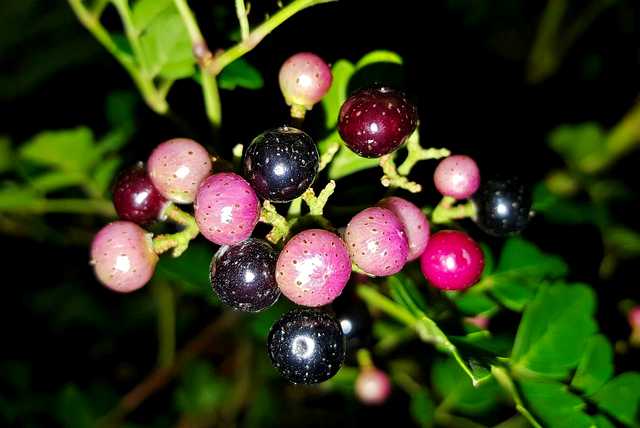
Porcelain Vine (Ampelopsis brevipes) stands out as a unique climbing plant known for its striking visual attributes, especially during the fall months. One of its most enchanting features is its vibrant berries, which change color as they ripen, transitioning from green in late summer to a stunning blue or purple in fall. This dramatic transformation creates an alluring focal point as the leaves, too, blaze with yellow and reddish hues, making it an alluring addition to any garden.
This vine is relatively fast-growing and thrives in both full sun and shade, giving gardeners flexibility in placement. Porcelain Vine is often praised for its ability to tolerate a wide range of soil conditions; however, it flourishes best in well-drained, fertile soils. It is also noteworthy for its connection to cultural history; the name “Porcelain Vine” comes from the unique appearance of its berries, reminiscent of fine porcelain.
While this vine is generally considered non-invasive, it can still spread aggressively in favorable conditions. To manage its growth, regular pruning is recommended, particularly in spring to encourage fresh and vigorous shoots. The colorful berries and attractive foliage of Porcelain Vine bring a delightful touch to the fall landscape, making it an excellent choice for gardeners looking to make a statement with their climbing plants.
Climbing Hydrangea

Climbing Hydrangea (Hydrangea anomala subsp. petiolaris) is a captivating vine that not only offers stunning blooms but also transforms into a beautiful tapestry of color as fall approaches. Its large, lacecap blossoms appear in late spring and early summer, bringing an abundance of white or pale creamy flowers that eventually turn to subtle hues of green. As autumn sets in, the leaves transform to rich shades of yellow and gold, adding a warm glow to the garden environment.
This unique climber is particularly valued for its ability to thrive in shaded environments, where many other climbing plants may struggle. Climbing Hydrangea can cling to various surfaces using aerial roots, which enables it to grow on walls, fences, and trees without needing hardware for support. Once established, it requires minimal maintenance—just periodic pruning to control growth and shape.
Beyond its visual allure, Climbing Hydrangea is notable for its ability to attract pollinators such as bees and butterflies. Additionally, it is a resilient plant, capable of withstanding a range of climatic conditions, making it a great candidate for diverse landscapes. This climbing vine’s combination of lush foliage, beautiful blooms, and vibrant fall color renders it a standout choice for enhancing garden aesthetics during autumn.
Trumpet Honeysuckle

Trumpet Honeysuckle (Lonicera sempervirens) is a wonderful climbing plant that captivates with both its lush foliage and tubular flowers. As the name suggests, this vine produces striking, trumpet-shaped blossoms that come in shades of red, orange, and yellow—colors that echo the warm hues of fall. Blooming from spring through fall, the flowers evoke a sense of nostalgia and charm, inviting hummingbirds and butterflies to your garden with their invigorating nectar.
Its deciduous leaves transition beautifully into deep greens in summer, gradually shifting to yellows and burnt oranges as the seasons change. This natural transformation provides an additional layer of beauty that aligns perfectly with the autumn aesthetic. One of the admirable qualities of Trumpet Honeysuckle is its ability to flourish in various conditions, thriving in partial shade to full sun and adaptable to different soil types, provided there is good drainage.
Beyond its ornamental appeal, this honeysuckle is also valued for its hardiness; it is a resilient plant that can tolerate drought once established and resists many common pests and diseases. Notably, avoiding invasive varieties is important to keep the balance in your garden ecosystem. By incorporating Trumpet Honeysuckle into your climbing plant collection, you can enrich your landscape with vibrant fall colors and support local wildlife, making it a multifaceted addition to any garden.
Other Climbing Plants That Have Vibrant Fall Color
While we’ve highlighted some exceptional climbing plants, many others also exhibit spectacular fall foliage worth considering for your garden. Each of these plants brings unique textures and colors that can enhance vertical spaces, creating a dynamic display as the season progresses.
Japanese Wineberry (Rubus phoenicolasius): Known for its shimmering, reddish-purple foliage, Japanese Wineberry offers both aesthetic and practical benefits. Its delicate stems are adorned with striking thorns, but the effort is rewarded with clusters of sweet, juicy berries in late summer, attracting a variety of birds and insects. As fall sets in, the golden-yellow leaves give way to fiery orange tones, providing an eye-catching contrast to the lush greenery of neighboring plants.
Clematis ‘Sweet Summer Love’: This vigorous select variety of clematis blooms profusely with deep purple flowers that sway gracefully in the breeze. By late summer and into the fall, its foliage transitions into eye-catching golds and reds, framing the blooms. The visually stunning combination of vibrant flowers and colorful foliage makes it a prime contender for any vertical structure.
Climbing Rose (Rosa spp.): Many climbing rose varieties offer gorgeous, fragrant blooms throughout the growing season, making them beloved garden favorites. However, as the weather cools, rose leaves transform into warm fall colors, ranging from deep burgundy to sunny yellow. Their romantic appearance and rich foliage create a breathtaking display that adds a touch of elegance to any landscape.
Passionflower (Passiflora spp.): Renowned for its intricate, exotic flowers, Passionflower is a unique climber that captivates with its vibrant purple and white blossoms. As autumn approaches, the leaves shift to brilliant shades of red and orange, creating a vivid contrast against the colorful flowers. This plant can be a stunning focal point in your garden while serving as a host for various butterfly species.
By incorporating these fall climbers into your garden, you can achieve a continuous display of colors and textures throughout the season. These climbing plants create a welcoming environment while also enhancing the overall appeal of outdoor spaces—ensuring your landscape remains inviting and visually captivating long after summer has faded.



